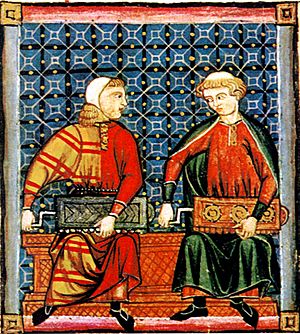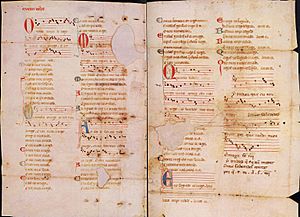Galician-Portuguese lyric facts for kids
In the Middle Ages, the Galician-Portuguese lyric, also known as trovadorismo in Portugal and trobadorismo in Galicia, was a lyric poetic school or movement. All told, there are around 1680 texts in the so-called secular lyric or lírica profana (see Cantigas de Santa Maria for the religious lyric). At the time Galician-Portuguese was the language used in nearly all of Iberia for lyric (as opposed to epic) poetry. From this language derives both modern Galician and Portuguese. The school, which was influenced to some extent (mainly in certain formal aspects) by the Occitan troubadours, is first documented at the end of the twelfth century and lasted until the middle of the fourteenth, with its zenith coming in the middle of the thirteenth century, centered on the person of Alfonso X, The Wise King. It is the earliest known poetic movement in Galicia or Portugal and represents not only the beginnings of but one of the high points of poetic history in both countries and in Medieval Europe. Modern Galicia has seen a revival movement called neotrobadorismo.
The earliest extant composition in this school is usually agreed to be Ora faz ost' o senhor de Navarra by João Soares de Paiva, usually dated just before or after 1200. Traditionally, the end of the period of active trovadorismo is given as 1350, the date of the testament of D. Pedro, Count of Barcelos (natural son of King Dinis of Portugal), who left a Livro de Cantigas (songbook) to his nephew, Alfonso XI of Castile.
The troubadours of the movement, not to be confused with the Occitan troubadours (who frequented courts in nearby León and Castile), wrote almost entirely cantigas (although there were several kinds of cantiga) with, apparently, monophonic melodies (only fourteen melodies have survived, in the Pergaminho Vindel and the Pergaminho Sharrer, the latter badly damaged during restoration by Portuguese authorities). Their poetry was meant to be sung, but they emphatically distinguished themselves from the jograes who in principle sang, but did not compose (though there is much evidence to contradict this). It is not clear if troubadours performed their own work.
Beginning probably around the middle of the thirteenth century, the songs, known as cantares, cantigas or trovas, began to be compiled in collections known as cancioneiros (songbooks). Three such anthologies are known: the Cancioneiro da Ajuda, the Cancioneiro Colocci-Brancuti (or Cancioneiro da Biblioteca Nacional de Lisboa), and the Cancioneiro da Vaticana. In addition to these there is the priceless collection of over 400 Galician-Portuguese cantigas in the Cantigas de Santa Maria, which tradition attributes to Alfonso X, in whose court (as nearly everywhere in the Peninsula) Galician-Portuguese was the only language for lyric poetry (except for visiting Occitan poets).
The Galician-Portuguese cantigas can be divided into three basic genres: male-voiced love poetry, called cantigas de amor (or cantigas d'amor) female-voiced love poetry, called cantigas de amigo (cantigas d'amigo); and poetry of insult and mockery called cantigas d'escarnho e de mal dizer. All three are lyric genres in the technical sense that they were strophic songs with either musical accompaniment or introduction on a stringed instrument. But all three genres also have dramatic elements, leading early scholars to characterize them as lyric-dramatic.
The origins of the cantigas d'amor are usually traced to Provençal and Old French lyric poetry, but formally and rhetorically they are quite different. The cantigas d'amigo are probably rooted in a native song tradition (Lang, 1894, Michaëlis 1904), though this view has been contested. The cantigas d'escarnho e maldizer may also (according to Lang) have deep local roots. The latter two genres (totalling around 900 texts) make the Galician-Portuguese lyric unique in the entire panorama of medieval Romance poetry.
See also
 In Spanish: Lírica galaicoportuguesa para niños
In Spanish: Lírica galaicoportuguesa para niños
- List of Galician-Portuguese troubadours
- Cantiga de amigo
- Cantiga de amor
- Cantigas de escárnio e maldizer



